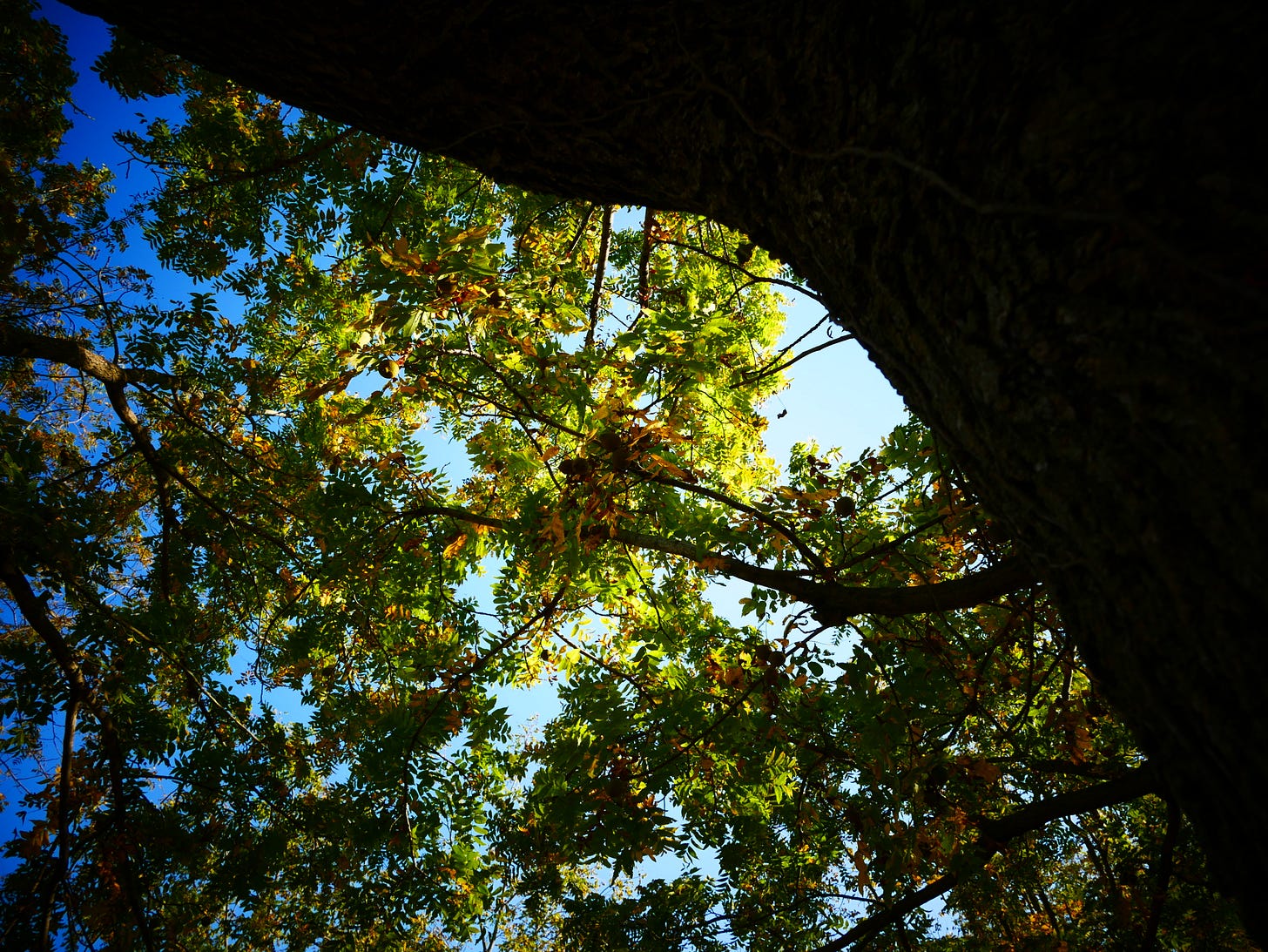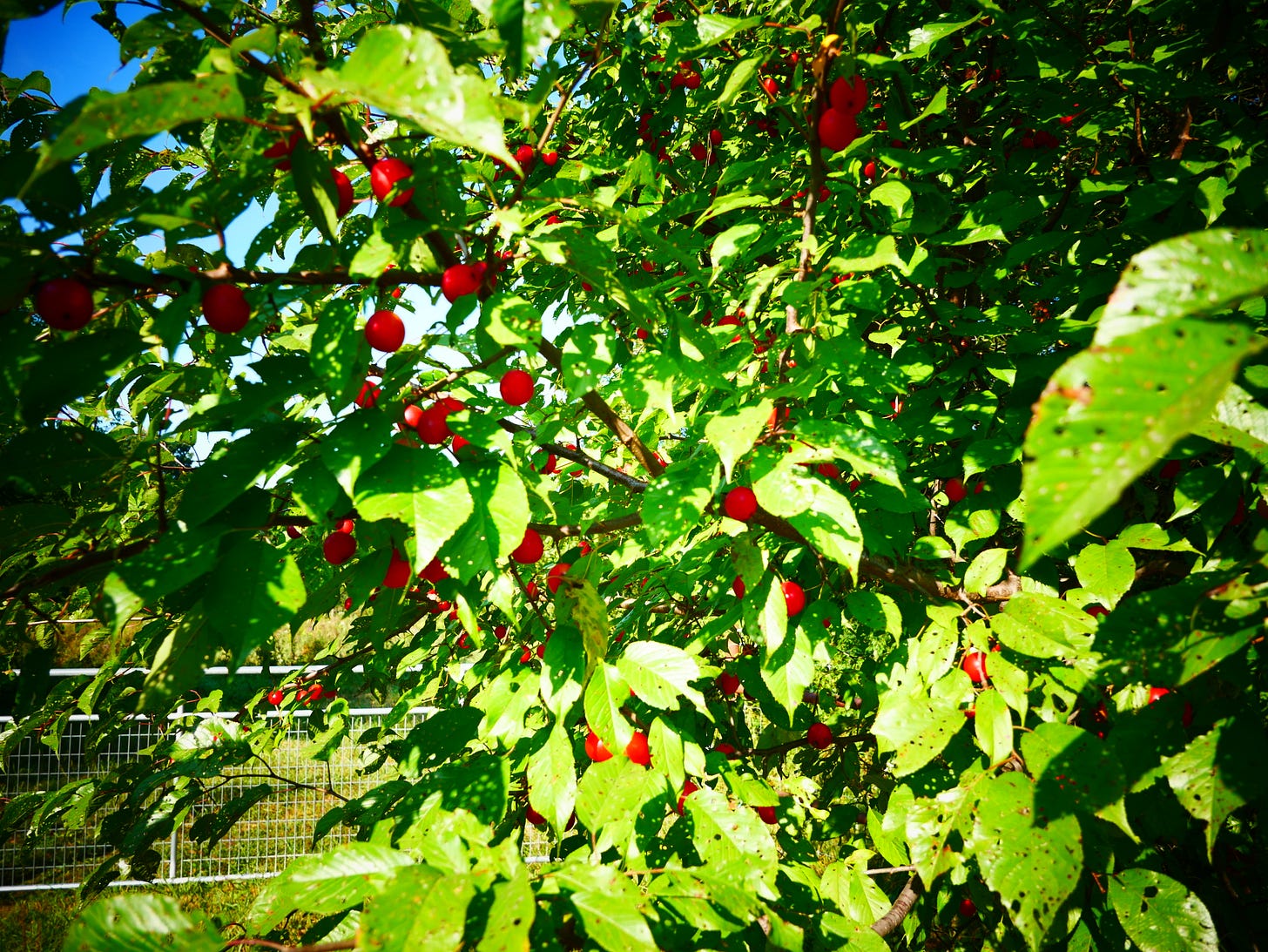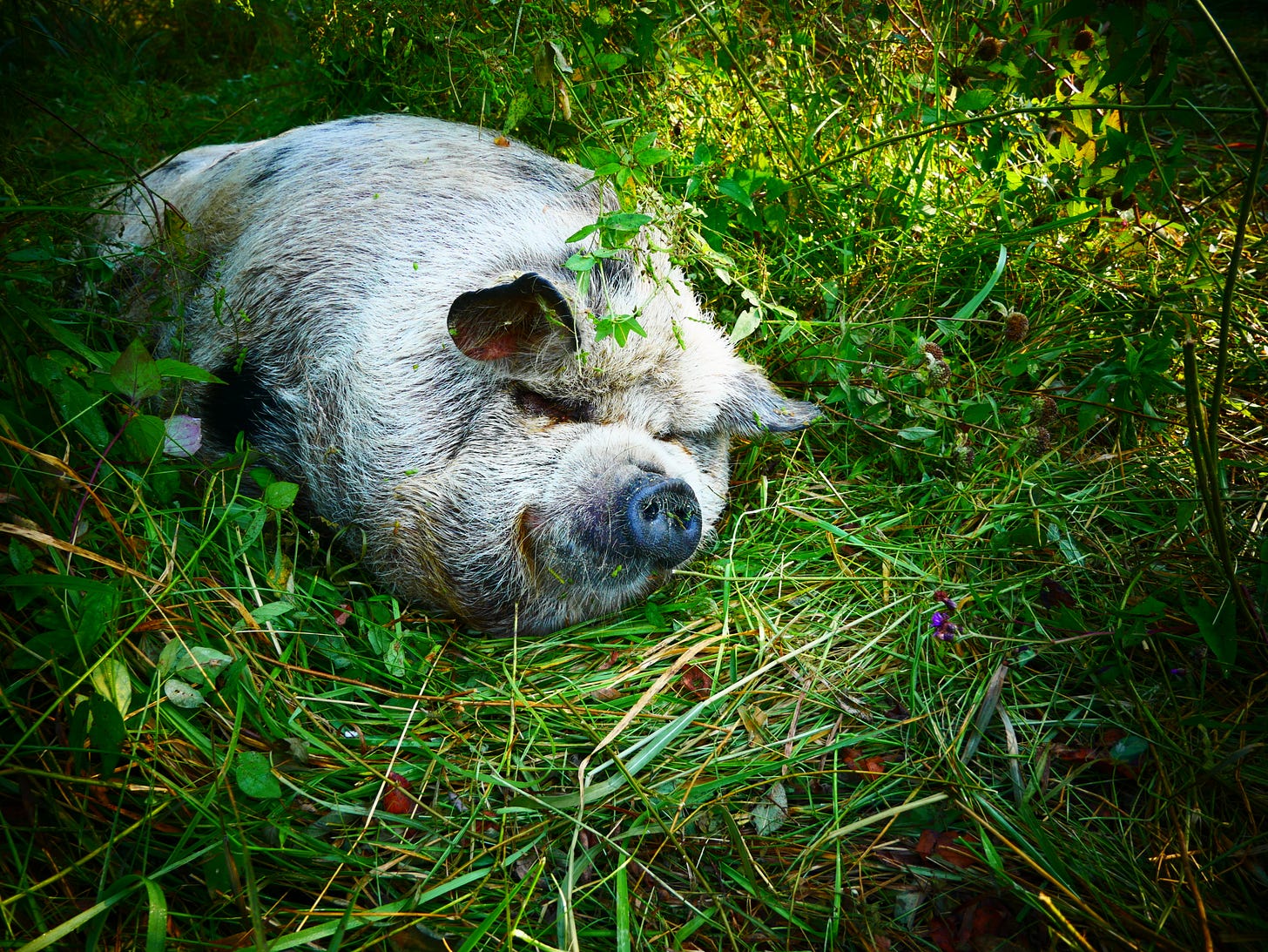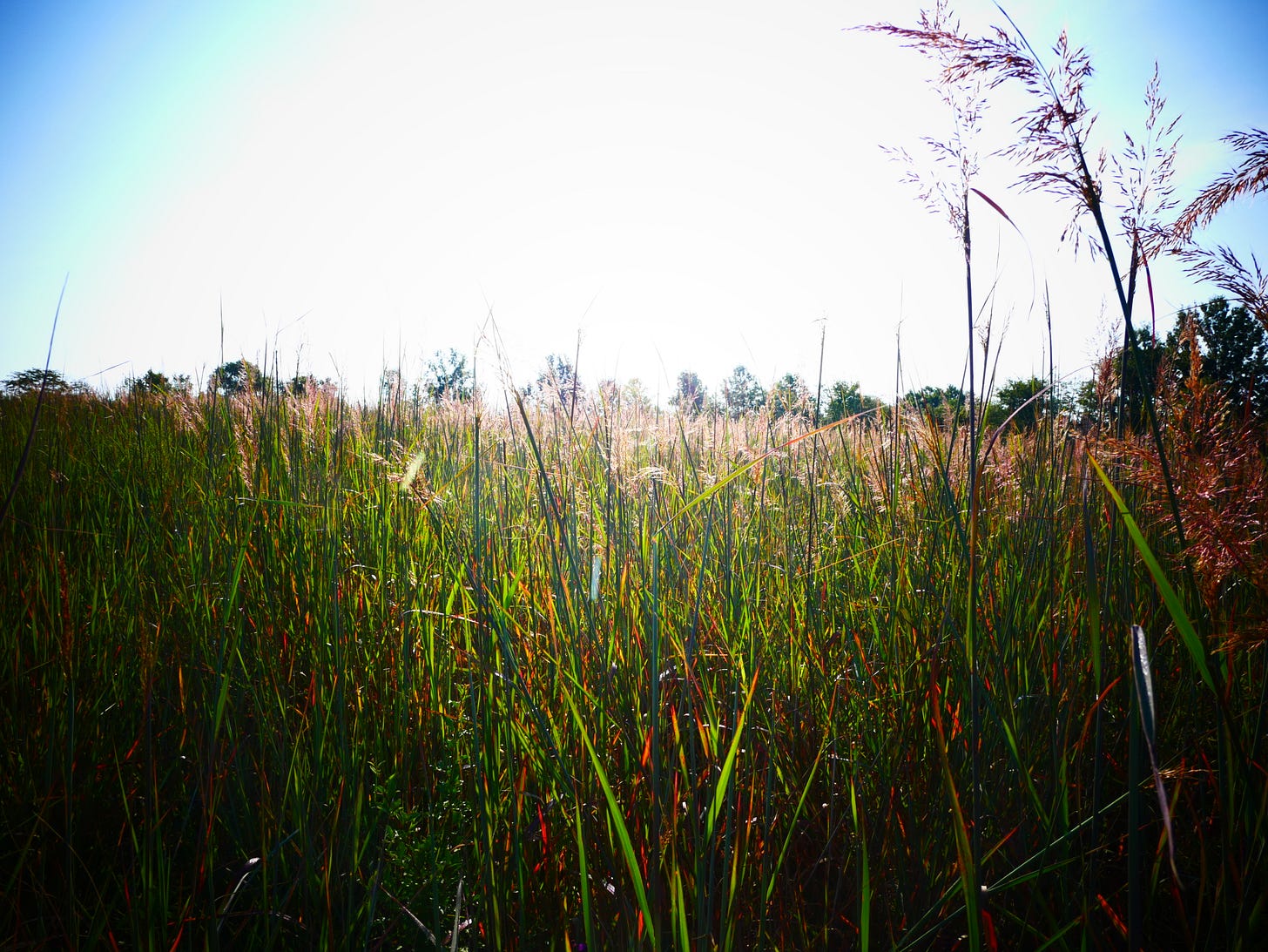Dead Butterflies
plus goo, employment, and black walnuts
There has been some change in the air. It’s thin and dry, and the reeling buzz of cicadas sing through it clear and crisp. The cottonwood leaves are drying, fading to tarnished gold, clacking and slapping in the arid breeze. The fine fronds of honey locust have dried down to a mottled collection of desiccated tears that rain slowly on the cracked clay of the prairie. Small armies of locusts are hopping from blade to flowering blade down in the tall grass, and it has not significantly rained in three weeks.
The groundhogs are fattening and digging. Pin oaks drop acorns. The swollen fruit of black walnut, pendulous with ripe seed, hangs from laden branches. Our kitchen is full of baskets and buckets and boxes of tomatoes, peppers, eggplant and long beans– the cellar door blocked with potatoes, the Asian pear trees shrugging with a bounty of sugar, and all of it surrounded with a fruit fly haze, if not yellow-jackets, that excavate the sweetness from rotting fruit flesh.
Vegetation has given way to fruiting– the world underlaid by a current of photosynthetically produced energy that cycles from sun to leaf to root to flower now made tangible in the form of ripe nutrition that we can now grasp like fattening groundhogs. The pigs stalk fatly through their paddocks, batteries of pure solar energy that snooze in the thinning shade of dry trees. Our barnyard is full of fowl –waddling ducks in resplendent plumage that strut unknowingly in and beneath the wild plum thickets, to peck at bloody fruit flesh, unaware that in the coming weeks they will too meet the knife and become consumed, their energy stored in our bodies as the world again grows dormant, still.
It is only September, and there will be hot days ahead, but for now the mornings have an energizing, if ominous chill. The days have grown perceptibly shorter, the sun lower, arching in tighter spirals. After dinner work happens in the twilight, or not at all. We wash dishes with headlamps outdoors. We are making arrangements to slaughter our steer when the grass fades and the pastures flush their sugars below ground for the coming cold. The hunger of locusts and yellow-jackets and the ashy faded leaves of tired cottonwoods usher us into the springtime of death.
Death is change, and change is continuous, but we do not have enough data to understand the true permanence of death. I know the gut and featherpiles of last November now squirm with new life– worms and larval casings and secreted snake eggs. I know the buckets of cull fruit, the bug-eaten apples and rotten pears that I retrieve from the orchard floor are becoming the living flesh and fat and growing bones of swine. I know that some of the butterflies emerging underleaf that feed on the nectar of fiery purple ironweed will not make it to their final overwintering places nearer the equator, but that their progeny might, that we have now shifted away from the spiral of sun on our side of earth. As a poetic object, the change from egg to caterpillar to chrysalis to adult butterfly is obvious– but what about the countless larvae eaten by birds, trampled by grazing cattle, mown down by brush hogs, or otherwise stunted in their cocoons? What of the goo inside the cocoon? What does it feel or understand? It certainly looks painful, as transitions often are.
I myself am sometimes unaware of if I’m changing or just dying– and upon consideration, the answer is probably both, or more accurately, that I’m goo.
It has taken longer than I expected to sit and write lately. The tomatoes swell with ripeness ceaselessly in the garden. Some of the burst and rot on the trellises– decaying as they slide through the cracking earth. Beans need harvesting and threshing. The dry spell has stunted pasture growth, and the result is that our livestock require more frequent movement– the tractor is broken, again, and my scythe is dull and the grass ever so lignified. The children have returned to school, which somehow creates more work for me. An otherwise rain-sodden summer has spoiled the root systems of our plants, and I must constantly water them now in this flash drought. And then there’s the matter of my newfound gainful employment.
I have not been employed for around 13 years. I have, however, taken many odd jobs, receiving small, untraceable transactions of cash. I have marketed produce, written freelance articles, and even filed Schedule F (as in ‘farm’) tax forms in order to piece together enough of a tax refund to keep the whole project functioning. I’ve even regularly sold raw milk on the black market, across state-lines, before that was the “cool” thing. But, in the larger scheme of economic participation, I have intentionally remained a non-entity, so as to not support the purchase implements of war for our state and others via taxation, nor feel tempted by the siren call of consumerism, and to generally spend more time outside of the standardized work-for-minimal-survival paradigm. I’ve also long believed myself to be unemployable, as an ADHD person.
Then I got offered a two-year internship, writing about trees– something I’d gladly do for free. It wouldn’t be considered a lucrative check by conventional standards, but per hour it’s way better than farming.
There’s a reason farming is no longer a sought-out occupation in the developed world– like many professions, it’s hard and sometimes it sucks. Do I spend hours a day outside with marvelous animals in and among splendid crops? More or less. Am I deeply connected to land, food, and natural cycles? Clearly. Is it one of the most meaningful occupations for a human to partake in? Undoubtedly. But at the end of the day, or at least the season, I sometimes despair.
I once believed that if I spent the time most people spend being employed directly attending to my own physical needs –food, water, and shelter– that I could short-circuit the capitalist system and derive survival and meaning from a life spent directly in contact with my physical necessities. This is still mostly true for me, so long as it takes place within the larger context of community, except for a few key necessities, listed below:
Personal Health- I have watched many people in my family gradually become crippled from manual labor. Farming, especially farming with integrity, extracts a physical toll from me that I’ve begun to fear, as I grow increasingly creaky. I was pretty sure I could side-step these issues by involving myself in a sudden, tragic farm accident if need be– getting crushed by a felled tree, being run over by machinery, or slipping suddenly into the untold horror of drowning in a grain-bin. As I’ve aged and dropped the live-fast-die-young mentality (I am not leaving a good-looking corpse), it has become apparent that I need to survive agriculture in relatively good shape because of…
The Wellbeing of my Children- Kids these days don’t know how good they’ve got it, and despite the exhortations of regressive online homesteaders and religio-cultists everywhere, that’s a sign of a healthy society. I believe we owe it to children everywhere, especially those nearest to us, the opportunity to pursue their dreams. Let them be whatever they dare– because the world needs more than clean food. I wish I’d had the encouragement to do the same at their age.
Of course, to give my kids the advantage in life I’d like them to enjoy, they need more than food, water, and shelter– access to education, tools to explore their world, and a degree of leisure in my life to be present in theirs requires some degree of economic cushion. Say what you will about voluntary simplicity, raising kids in poverty sucks. Another way to encourage kids to follow their dreams is to not drop bombs on them, which is why I still won’t be paying taxes. Which brings us to…
Doing Something Bigger– Providing boutique foods for those who can afford them only does so much to change the world– and it still hardly covers my expenses, let alone my labor. I do not regret my time spent hustling organic, pasture-raised heritage breed turkeys, heirloom tomatoes, or niche goat cheddar, but I do think that we in the sustainable agriculture world sometimes sell ourselves short when we refuse to approach scale and scope pragmatically. The view from a midwestern farm is insular, even (sometimes especially) if you’re concerned with sustainability and justice. Sometimes it feels like all we can do is take care of our little corner of ownership. We relegate ourselves to the margins. I suppose I’m tired of being “alternative”. I don’t think we can afford for sustainable agriculture to be the alternative any longer– so if I can find ways to prioritize my time that lead to more wide-spread adoption of solutions-based practices, I will gladly choose that.
So those are the things I’ve been thinking about it in my gooey, transformative state. Also, the work is part-time which allows me to continue toiling as much as I want, and the folks I work with also have a simultaneously radical and pragmatic vision for the Midwest, and I want to help.
I can’t pretend to know what caterpillars know, but I somehow doubt that they understand what they will become once they turn into chrysalis goo. In fact, it isn’t a guarantee that we know either. Take for instance the relationship between black swallowtails and chalcid wasps. The black swallowtail (Papilio polyxenes) larva is not poisonous, but looks it eats enough toxic compounds to change its flavor, effectively reducing predation from most birds and predatory insects. Once it enters the chrysalis stage, however, chalcid wasps will bite a hole through their fleshy chambers and inject their own larval eggs. What emerges from the goo is not a butterfly, but a small brood of parasitic wasps. Motionless goo is a vulnerable state to be in– and one that I’m personally trying to avoid. What I haven’t figured out is if I’m in the goo now, or if I’ve been the goo all these years.
This morning I took my brush-scythe out along an old fence-line, to mow a new paddock path between the squirrel-planted pin oaks and black walnuts and tired choke-cherries that drop their dry limbs on the duff and undergrowth of golden alexanders. In places we have removed the old rusted barbed-wire that ran from hedge-post to hedge-post, though my blade still clicks against the buried and corroded coils that the growing edge of woodland reclaims. This year’s black walnut crop appears fairly heavy for this young, regenerating area, and being as though I’m currently working to produce a black walnut info-sheet, for work, my interest is peaked in this tree that I’ve often ignored.
The Eastern Black Walnut (Juglans nigra) occupies a unique status among trees here in the agricultural Midwest. As I’ve mentioned earlier, and will examine further in the almanac, many farmers generally, and row crop farmers specifically, seem to have it in for trees– both the pioneering, “weed” trees like honey locust and mulberry, and some of the old timers that stand in the way. In my time here in Northeast Missouri, I have repeatedly watched big old bur oaks and cottonwoods get cut down at field edges for the sake of slightly expanding the width of a spray boom or other equipment. This is what they call this efficiency; larger equipment allows fewer operators to farm more acreage, which allows for further conglomeration and a slight increase in the bottom line… sometimes. At the very least, it seems the equipment manufacturers, seed and chemical companies and agriculturally focused banks do alright with this system of “bigger is better”.
However, as those old witnesses the oaks and spreading maples, stately hickories and proud cottonwoods fall one by one at the edge –trees which would ordinarily serve to protect our watersheds from excess nitrates, phosphorous and the like, or feed the web of wilderness surrounding us– a farm with a stand of tall, straight-trunked black walnut seems to somehow kindle neon-lit dollar signs behind the eyes of otherwise dismissive farmers. Of course, like so many other commodities, the loggers take their cut, and the mill takes theirs, any high-grade veneer would is sold at a premium, and the actual “stumpage” value left to the farmer may not be the retirement plan they’d now expected… particularly if retirement takes place on a now denuded landscape. The economic scheme of black walnut timber is something of a gamble: you harvest once, get what you get, and the accumulated events of the previous decades of growth influence the quality and price of that single harvest of timber.
If the economic value of a tree (or any organism) dictates how that tree is cultivated and managed, then the ecological role of that tree will necessarily shift. Tightly spaced, straight-up-and-down walnut does not perform the same function as the sprawling, nutrition rich native nut-tree and pioneer plant of disturbed sites and young forests it has evolved to become. It then naturally follows that to maintain intact ecologies in highly fragmented environments like the corn belt, landowners will either have to find economic incentives which value trees and forests in a more naturalized state or arrangement. While timber quality black walnut is not an impossibility in healthy stands of naturally managed forest, there will be plenty of “worthless” walnuts, if we are only looking for one yield.
This is why I refuse to settle on one “yield” for any of the livestock we manage on our farm– the goats produce milk, meat, and hides, but most importantly, they browse the landscape, and help to manage wood vegetation. They excel at consuming invasive weeds. Our cows do more than feed us and our neighbors, they fill a grazing niche on our tallgrass prairie left unfulfilled with the extirpation of bison. If we were to work to develop a tree-crop industry centered on more than timber, if we allowed trees their full expression of tree-ness, as we do with our cows and goats and poultry and pigs, the midwestern farmscape could perhaps better resemble our at-risk native ecology, both in terms of physical function and resilience to uncertain times.
The current economic conditions are ominous for commodity crops. China won’t be buying our pork or soybeans. The market relief offered to farmers by ethanol production is in question. New pests, diseases, and climate extremes threaten the tenuous positioning of our few commodity crops– the question is not whether agriculture should supplant native ecosystems, but whether or not agriculture can function as an ecosystem that supports the diverse needs of other plants, insects, animals, fungi, microbes, and humans. There are few productive temperate ecosystems that function without us, so despite my own low-level annoyance with this species, I’m fully aware that ecological action cannot be misanthropic, by principle.
Pulling the fiberglass fence-rods up from the parched earth as I move hogs from point to point where they might snooze in the shade and knock down encroaching brush and fatten themselves (further) on acorns, I kick dry pig-shit down into the widening cracks. The rain situation has become dire, but I make the best out of it by forcing fertility and organic matter deep into the earth where it will feed the unseen microbiology below. It’s only a few days before chestnut harvest, and we are daily working to stow away tomatoes and peppers for the uncertain winter. We work to fatten the stock for the darkness and cold which seems so far away in the heat and glint of early September, but I often wonder if we do enough to feed the soil, which has been starved by generations of extraction– a few bushels and coins at a time.
The locusts are buzzing and feeding in the tall grass as I stomp through, and dangling from a caterpillar-eaten milkweed I find a single aborted monarch chrysalis, dull and dead. And internally, as the amorphous goo of fears for the future, could-be’s and should-be’s sloshes and churns in my hungered sides, I feel the pang of what I hope is some becoming. As a species, we’ve had plenty of time to formulate, synthesize, and pupate– it would appear that we must change soon, or die.










thanks for this work of writing :)
really resonate with the hope for becoming, and that overwhelming feeling of change soon or die.
also really appreciated the point(s) about how ecological health and restoration are currently dependent on and tied to the economy, and the importance of providing "economic incentives which value trees and forests in a more naturalized state or arrangement."
Speaking of more harvests from walnuts, my husband just bought a bag of sandblating grit that he claims is made from crushed walnut shells. Not that there's going to be a big market for that sort of thing, but it's just kind of surprising to me.